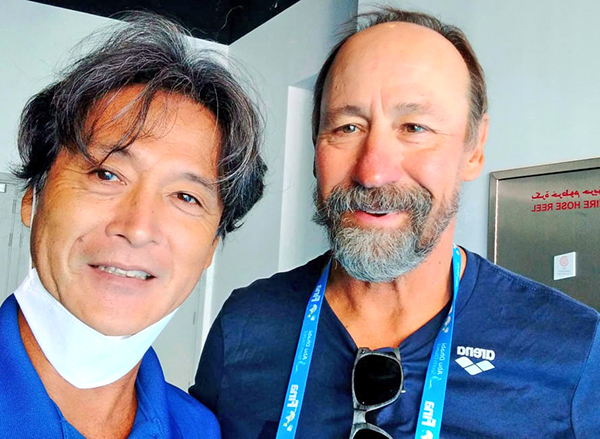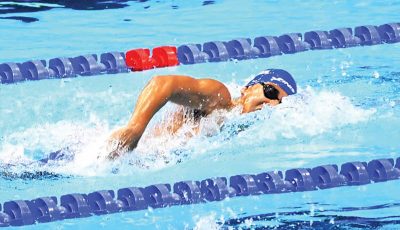Coach Hiro took notes from Abu Dhabi trip

CNMI national swim coach Hiroyoki Kimura, left, poses with U.S. National Swim Team head coach Dave Salo during a break in the 15th FINA World Swimming Championship last month in Abu Dhabi, United Arab Emirates. (Contributed Photo)
Hiroyoki Kimura didn’t only steer CNMI national swimmers to splendid performances in the 15th FINA World Swimming Championship last month in Abu Dhabi, United Arab Emirates, but he also did his homework by exchanging notes with other coaches.
One of the coaches the CNMI national swimming coach was fortunate to talk to was U.S. National Swim Team head coach Dave Salo.
“He is one of best coaches in the world. But the reason why I like him very much is not that reason alone.”
He went on to explain that he and Salo both belong to the International Swimming League where the latter serves as the Tokyo Frogkings head coach.
“In that team, many Japanese swimmers are active as the main members of the team. Coach Dave has a lot of Japanese swimming coach friends. One of them, coach Yuichiro Sasaki, is the head coach of the Chukyo University swim team and my son, Kensuke, swam under him for four years.”
Kimura said Salo is a very theoretical and innovative coach, adding that he learned from Salo a lot and even incorporated some of the U.S. national coach’s drills in his own training for the 50m-100m sprint.
“He never gets caught up in the past and he constantly tries new things. He is very good at enlivening the team and does not have long meetings which is torture during competitions. Unfortunately, there are so many swimming coaches doing it. Despite being the head coach of the world’s best—the U.S. team—he treats coaches in small countries like me very kindly and politely. He was already a very respectable person even before becoming a coach.”
The Tsunami Saipan Swimming Center head coach also learned in Abu Dhabi that long-distance practices are not always optimum for training.
“Coaching is evolving year by year. Nowadays, it is said that the practice of just swimming a long distance is ineffective. Tsunami Saipan swimmers can swim 20 kilometers or 30 kilometers if they just swim. But the distance doesn’t make sense. Also, the practice of 100mX10 and the practice of (25mX4) X 10 has the same total distance. However, the load on the latter is much larger. The current mainstream practice is like that,” he said.
Kimura also was relieved that his insistence in sending the CNMI’s top male and female swimmers to the short course championship in Dubai was headed.
“This time, I was able to talk with many coaches from small countries like us and found out that every country sends their No. 1 and No. 2 swimmer to the FINA World Champs. That’s how most coaches responded to the invitation to the meet. I’m so glad that my thoughts were not wrong.”
Kimura added he’s happy that the CNMI is slowly developing swimmers that can compete in international meets like the 15th FINA World Swimming Championship.
“If we have enough number of eligible swimmers, we should always select the Top 2 male and Top 2 female. If we don’t have enough swimmers, we can use any distribution, 2-1, 1-2, or 1-1.”
Kimura and national swimmers Juhn Tenorio, Jinnosuke Suzuki, and sisters Asaka and Shoko Litulumar made up the CNMI delegation to the UAE. They were accompanied by Northern Marianas Swimming Federation representatives Richard Sikkel and Hiroko Tenorio.
























